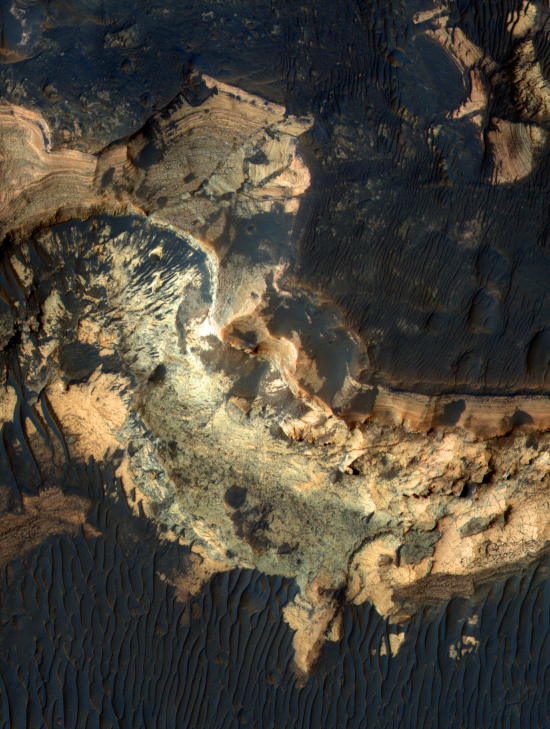A potential landing site for next Mars rover
This week’s release of cool images from Mars Reconnaissance Orbiter included the color image below of a region on the floor of Holden Crater, one of the four possible landing sites for Curiosity, the Mars Science Laboratory planned for launch later this year. (If you want to see the entire image at higher resolution, you can download it here.)
Two things that immediately stand out about this image (other than this looks like an incredibly spectacular place to visit):

First, the layers visible on the canyon walls, reminiscent of the walls of the Grand Canyon, indicate an active past. Repeatedly geological processes deposited a new layer of material on the floor of this crater, slowly building up the surface. Later, other geological processes acted to erode away the canyon, exposing the layers. The important question of course is finding out what those geological processes were.
Second, what causes the wide range of different colors? According to the caption, the dark materials are windblown, while the lighter stuff is from layered deposits. This description is what scientists call “hand-waving” (since waving their hands in the air helps disguise the fact that they really don’t know that much). Though the dark stuff is obviously windblown surface deposits, why are they so much darker than the layers below?
Finding out the chemical composition of these kinds of materials, as well as what made the layers, will be one of Curiosity’s prime goals. Sadly, we only have one rover, and innumerable places on Mars to visit.
On Christmas Eve 1968 three Americans became the first humans to visit another world. What they did to celebrate was unexpected and profound, and will be remembered throughout all human history. Genesis: the Story of Apollo 8, Robert Zimmerman's classic history of humanity's first journey to another world, tells that story, and it is now available as both an ebook and an audiobook, both with a foreword by Valerie Anders and a new introduction by Robert Zimmerman.
The print edition can be purchased at Amazon or from any other book seller. If you want an autographed copy the price is $60 for the hardback and $45 for the paperback, plus $8 shipping for each. Go here for purchasing details. The ebook is available everywhere for $5.99 (before discount) at amazon, or direct from my ebook publisher, ebookit. If you buy it from ebookit you don't support the big tech companies and the author gets a bigger cut much sooner.
The audiobook is also available at all these vendors, and is also free with a 30-day trial membership to Audible.
"Not simply about one mission, [Genesis] is also the history of America's quest for the moon... Zimmerman has done a masterful job of tying disparate events together into a solid account of one of America's greatest human triumphs."--San Antonio Express-News


The Mawrth Vallis region, another one of the “final four”, has been shown to be much more mineralogically diverse. This mineralogical diversity has the potential to tell us a lot more about aqueous processes during early Martian history. Certainly Holden crater and the other candidate sites have a lot to tell us as well.